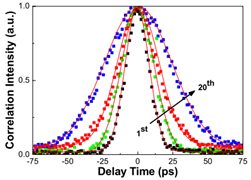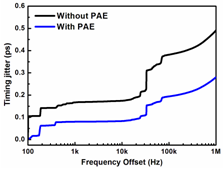|
High-order
rational harmonic mode-locking and
pulse-amplitude equalization of SOAFL
under optical injection
Professor Gong-Ru Lin
Graduate Institute of Photonics and
Optoelectronics, National Taiwan
University
臺灣大學光電所
林恭如教授
First
of all, we demonstrate the 20th-order
rational harmonic mode-locking (RHML)
semiconductor optical amplifier fiber
laser (SOAFL) pulses by using 1 GHz
backward dark-optical comb injection,
and discuss the competition between
mode-locking mechanisms in the SOAFL at
high-gain and strong optical injection
condition at higher RHML orders. As the
rational harmonic order increases up to
20, the auto-correlation traces and
optical spectra of the RHML-SOAFL at
different RHML orders are
characterized. The Fig. 1. shows that
the normalized auto-correlation traces
of the SOAFL at 1st, 5th, 10th,
and 20th RHML orders gradually changes the
pulsewidth from 13.5 to 35 ps. The Fig.
2. exhibits that the SOAFL spectrum with
red-shifted wavelength and reduced
linewidth from 12 to 3 nm at RHML order
increases to >8 reveal a less pronounced
high-order RHML mechanism when competing
with the continuous-wave lasing
mechanism. Furthermore, in order to
solve the problem of uneven RHML
pulse-amplitude, we use the reshaped
10-GHz gain-switching FPLD double-peak
pulse to reconstruct the gain profile of
SOA in time domain, the 4th-order RHML-SOAFL is demonstrated for achieving
40-GHz RHML pulse-train with optimized
performance of pulse-amplitude
equalization (PAE). The Fig. 3. shows
the auto-correlation traces of 4th-order RHML pulse-train without and with PAE.
Such the indirect gain compensation
further balances the amplitude
fluctuation from 45% to 3.5% when
obtaining 40-GHz RHML pulse-train.
After initiating the PAE, the
uncorrelated phase noise contributed by
the residual ASE noise of the RHML-SOAFL
is significantly decreased, which leads
to a timing jitter reducing from 0.5 to
0.28 ps as shown in Fig. 4. and provides
an amplitude-equalization pulse-train
repeated at 40 GHz to meet the demand of
being a perfect RZ pulsed carrier for
its future application in OTDM network.
Reference: G. -R. Lin
et al., Optics Express, Vol. 18, No. 9,
pp. 9570-9579, Feb. 2010.
|
 |
 |
|
Fig. 1. The
auto-correlation traces of SOAFL at
1st, 5th, 10th,
and 20th RHML orders. |
Fig. 2.
Evolution on RHML-SOAFL spectra at
different RHML orders. |
|
 |
 |
|
Fig. 3. Auto-correlatted
traces of 40-GHz RHML pulse-train
without and with pulse-amplitude
equalization. |
Fig. 4. The
timing jitter of 40 GHz RHML
pulse-train without and with
pulse-amplitude equalization. |
Emitter
Apodization Dependent Angular Luminance
Enhancement of Microlens-Array Film
Attached Organic Light-Emitting Devices
Professor
Hoang-Yan Lin
Graduate Institute of Photonics and
Optoelectronics, National Taiwan
University
臺灣大學光電所 林晃巖教授
Taking
organic emitter apodization calculated
from electromagnetic theory as input,
the angular luminance enhancement of a
microlens-array-film (MAF) attached OLED
(organic light-emitting device) can be
further evaluated by ray-tracing
approach. First, we assumed artificial
emitters and revealed that not every
OLED with MAF has luminance enhancement.
Then, the OLEDs of different Alq3
thickness were fabricated and their
angular luminance measurement validated
simulation results. Mode analyses for
different layers were performed to
estimate the enhancement potential of
the MAF attached devices. In conclusion,
the organic emitters with higher
off-axis-angle luminous intensity cause
lower out-coupling efficiency but gain
higher enhancement after the MAF
attached.
|
Fig. 1. (a)
The simulated source apodization
varying Alq3 thickness
from electromagnetic theory; (b) the
simulated luminance from geometrical
optics; (c) the validation of
experimental results. |
|
Fig. 2. (a)
Mode ratios calculated by transfer
matrix method with embedded sources.
The blank area of each bar
represented the optical power ratio
of the surface plasmonic mode; (b)
the experimental mode ratios. |
|